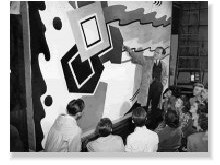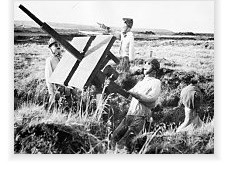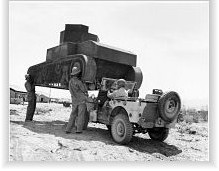


Armies
D
uring World War I, esteemed artists
Virginia SOLs in the following cirriculum areas are supported by this program:
USII.4b; USII.5a; USII.6a; USII.6b; USII.6c
C/T 6-8.3; C/T 9-12.1; C/T 9-12.3
CE.4; CE.12
Visual Arts: 6.11; 6.13; 6.15; 7.23; 7.30; 8.12; 8.14
AI.11; AI.14; AII.13; AIV.11; AIV.16
USII.4b; USII.5a; USII.6a; USII.6b; USII.6c
C/T 6-8.3; C/T 9-12.1; C/T 9-12.3
CE.4; CE.12
Visual Arts: 6.11; 6.13; 6.15; 7.23; 7.30; 8.12; 8.14
AI.11; AI.14; AII.13; AIV.11; AIV.16
Ghost

Massive Disinformation Campaigns
Bogus Military Installations
Nonexistent Troops
Dummy Equipment
Highlights



Discover how efforts to trick, confuse, and deceive our enemies took on a large role in World War I, helping to win the war against the Central Powers.
See why during World War II deception evolved into an art and science.
View amazing archival photos and original artifacts.
Learn about the importance of the phony force --FUSAG-- "commanded" by Gen. George S. Patton.
Meet the masters of deception who made it happen.
See why during World War II deception evolved into an art and science.
View amazing archival photos and original artifacts.
Learn about the importance of the phony force --FUSAG-- "commanded" by Gen. George S. Patton.
Meet the masters of deception who made it happen.
Spying, Trickery, and Deception
© History is a Hoot, Inc. 2003-2012
Join our email list and receive
Virginia Hall: America's Greatest Female Spy
Virginia Hall: America's Greatest Female Spy
secret



brought their considerable talents to the effort, designing strange painted patterns that, when applied to merchant and navy ships in particular, helped thwart the devastation caused by German U-boats.
Two decades later during the next global conflict, deception techniques evolved into highly sophisticated undertakings that included fake towns and inflatable tanks, airplanes, landing craft and yes, soldiers. Many of these specially designed inflatables were engineered by America's rubber companies as part of their contribution to the war effort.
Two decades later during the next global conflict, deception techniques evolved into highly sophisticated undertakings that included fake towns and inflatable tanks, airplanes, landing craft and yes, soldiers. Many of these specially designed inflatables were engineered by America's rubber companies as part of their contribution to the war effort.


